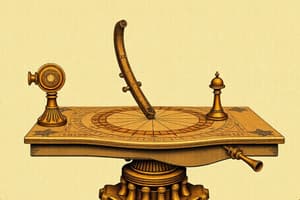Podcast
Questions and Answers
What is the first step in setting out the table?
What is the first step in setting out the table?
- Levelling (correct)
- Adjusting the tripod
- Orientation
- Centring
What is the purpose of centring the table?
What is the purpose of centring the table?
- To align the table with the magnetic north
- To place the table directly over the station on the ground (correct)
- To adjust the alidade for accurate sighting
- To ensure the table is level
Which of the following methods of orientation is described as fast but less accurate?
Which of the following methods of orientation is described as fast but less accurate?
- Orientation by alidade
- Orientation by trough compass (correct)
- Orientation by leveling
- Orientation by back sighting
Which component is used for centring the table?
Which component is used for centring the table?
What is the main goal of orientation when using multiple instrument stations?
What is the main goal of orientation when using multiple instrument stations?
In orientation by back sighting, what is drawn towards the next station?
In orientation by back sighting, what is drawn towards the next station?
What is crucial for maintaining consistency in orientation at different stations?
What is crucial for maintaining consistency in orientation at different stations?
What happens if the orientation is not properly executed?
What happens if the orientation is not properly executed?
What is one of the main purposes of the radiation method in plane table surveying?
What is one of the main purposes of the radiation method in plane table surveying?
Which component of the transit theodolite is primarily used for measuring vertical angles?
Which component of the transit theodolite is primarily used for measuring vertical angles?
In tacheometric surveying, what role does the stadia rod play?
In tacheometric surveying, what role does the stadia rod play?
What is indicated by checking for closing errors in open traverse surveying?
What is indicated by checking for closing errors in open traverse surveying?
Which of the following methods involves measuring distances at intervals using a leveling instrument?
Which of the following methods involves measuring distances at intervals using a leveling instrument?
What is the function of the anallatic lens in tacheometric surveying?
What is the function of the anallatic lens in tacheometric surveying?
What technique is used to measure both interior and exterior angles in theodolite surveying?
What technique is used to measure both interior and exterior angles in theodolite surveying?
Which surveying technique is primarily used for leveling over short distances?
Which surveying technique is primarily used for leveling over short distances?
What is the first step in leveling with a three-foot screw?
What is the first step in leveling with a three-foot screw?
When should the instrument be rotated by 180 degrees during the leveling process?
When should the instrument be rotated by 180 degrees during the leveling process?
What is parallax and how can it be eliminated?
What is parallax and how can it be eliminated?
What adjustment is necessary if the bubble does not remain centered after the 180-degree rotation?
What adjustment is necessary if the bubble does not remain centered after the 180-degree rotation?
What is the correct procedure to measure a horizontal angle with a transit theodolite?
What is the correct procedure to measure a horizontal angle with a transit theodolite?
Which action is performed after keeping the vertical circle at left during the angle measurement?
Which action is performed after keeping the vertical circle at left during the angle measurement?
What do you need to do if the image through the telescope is not clear?
What do you need to do if the image through the telescope is not clear?
In the leveling process, what is the purpose of rotating screws B&D?
In the leveling process, what is the purpose of rotating screws B&D?
What is the least count of the vernier scale described?
What is the least count of the vernier scale described?
Which reading needs to be taken first when using the vernier scale?
Which reading needs to be taken first when using the vernier scale?
What is the process of centering the instrument on the station?
What is the process of centering the instrument on the station?
What measurement must be combined with the vernier reading for the final observation?
What measurement must be combined with the vernier reading for the final observation?
Which method is NOT a part of the temporary adjustments of the theodolite?
Which method is NOT a part of the temporary adjustments of the theodolite?
What tool is used for accurate levelling of the theodolite?
What tool is used for accurate levelling of the theodolite?
What is the purpose of leveling the theodolite at the starting point A?
What is the purpose of leveling the theodolite at the starting point A?
What distinguishes a closed traverse from an open traverse?
What distinguishes a closed traverse from an open traverse?
What indicates that the theodolite is properly levelled?
What indicates that the theodolite is properly levelled?
What should be done if the bubble does not remain centered during the levelling process?
What should be done if the bubble does not remain centered during the levelling process?
Which method is preferred for measuring angles in theodolite traversing?
Which method is preferred for measuring angles in theodolite traversing?
In the traversing by included angles, which angle measurement can be classified as an exterior angle?
In the traversing by included angles, which angle measurement can be classified as an exterior angle?
What method would be suitable for surveying roads and pipelines with small deflection angles?
What method would be suitable for surveying roads and pipelines with small deflection angles?
When measuring an interior angle, how is it determined in relation to the direction of progress?
When measuring an interior angle, how is it determined in relation to the direction of progress?
Which tool is NOT used for measuring lengths in traversing?
Which tool is NOT used for measuring lengths in traversing?
What is the primary use of a closed traverse in surveying?
What is the primary use of a closed traverse in surveying?
Flashcards are hidden until you start studying
Study Notes
Plane Table Surveying
- Plane table surveying uses a plane table, alidade, and plumbing fork to create maps.
- The alidade is used to sight points and draw lines on the plane table.
- The plumbing fork is used to center the plane table over a ground station.
- There are three main methods for plane table surveying: radiation, intersection, and traversing.
Orientation
- Orientation ensures the plane table is aligned parallel to itself at different stations to prevent map distortion.
- Orientation by trough compass uses a compass to align the table with magnetic north. This is fast but less accurate.
- Orientation by back sighting involves aligning the alidade to a previously sighted point and rotating the plane table until the line of sight passes through the point.
Theodolite Surveying
- A theodolite is a surveying instrument used for measuring horizontal and vertical angles.
- It consists of a telescope, vertical circle, horizontal circle, and levelling screws.
- Theodolite adjustments include setting on the station, levelling up, and removing parallax.
Levelling the Theodolite
- Levelling the theodolite ensures that the instrument is horizontal.
- Three levelling screws are adjusted in pairs until the bubble of the plate level is centered.
- Four levelling screws are adjusted in pairs along opposite diagonals until the bubble is centered.
Measuring Angles
- Direct method involves pointing the telescope at a target and reading the angle on the horizontal circle - the angle is set to 0 degrees before sighting the first target.
- Deflection angle method measures the angle between a line and a reference line. The reference line is usually the previous line in the traverse.
- Magnetic bearing method uses a compass to determine the magnetic bearing of a line. The magnetic bearing is the angle between the line and magnetic north.
Theodolite Traversing
- Traversing is a surveying method used to determine the location of points by measuring angles and distances.
- A traverse is closed if it returns to the starting point and open if it ends at a different point.
- Traversing with included angles involves measuring the angle between each pair of lines forming the traverse.
- Traversing with deflection angles involves measuring the angle between each line and the previous line.
Measuring Angles
- Direct method involves pointing the telescope at a target and reading the angle on the horizontal circle - the angle is set to 0 degrees before sighting the first target.
- Deflection angle method measures the angle between a line and a reference line, usually the previous line in the traverse.
- Magnetic bearing method uses a compass to determine the magnetic bearing of a line, which is the angle between the line and magnetic north.
Theodolite Traversing
- Traversing is a surveying method used to determine the location of points by measuring angles and distances.
- A traverse is closed if it returns to the starting point and open if it ends at a different point.
- Traversing with included angles involves measuring the angle between each pair of lines forming the traverse.
- Traversing with deflection angles involves measuring the angle between each line and the previous line.
Tacheometric Surveying
- Tacheometric surveying uses a tacheometer to determine distances and elevations of points.
- A tacheometer is typically a theodolite with a stadia diaphragm.
- The stadia method uses the stadia diaphragm and a stadia rod to measure the distance between the instrument and the target.
Stadia Diaphragm
- The stadia diaphragm contains two horizontal lines that create a stadia interval.
- The stadia interval is used to calculate the distance between the instrument and the target.
- The stadia rod is a graduated rod that is held vertically at the target.
- The distance is calculated using the formula: distance = k * stadia interval + c, where k and c are constants.
Anallatic Telescope
- Anallatic telescopes are used in tacheometric surveying to eliminate the constant (c) in the distance formula.
- With an anallatic telescope, the distance is simply calculated by multiplying the stadia interval by the constant (k).
- Anallatic lenses are incorporated into the telescope to achieve this.
Studying That Suits You
Use AI to generate personalized quizzes and flashcards to suit your learning preferences.




